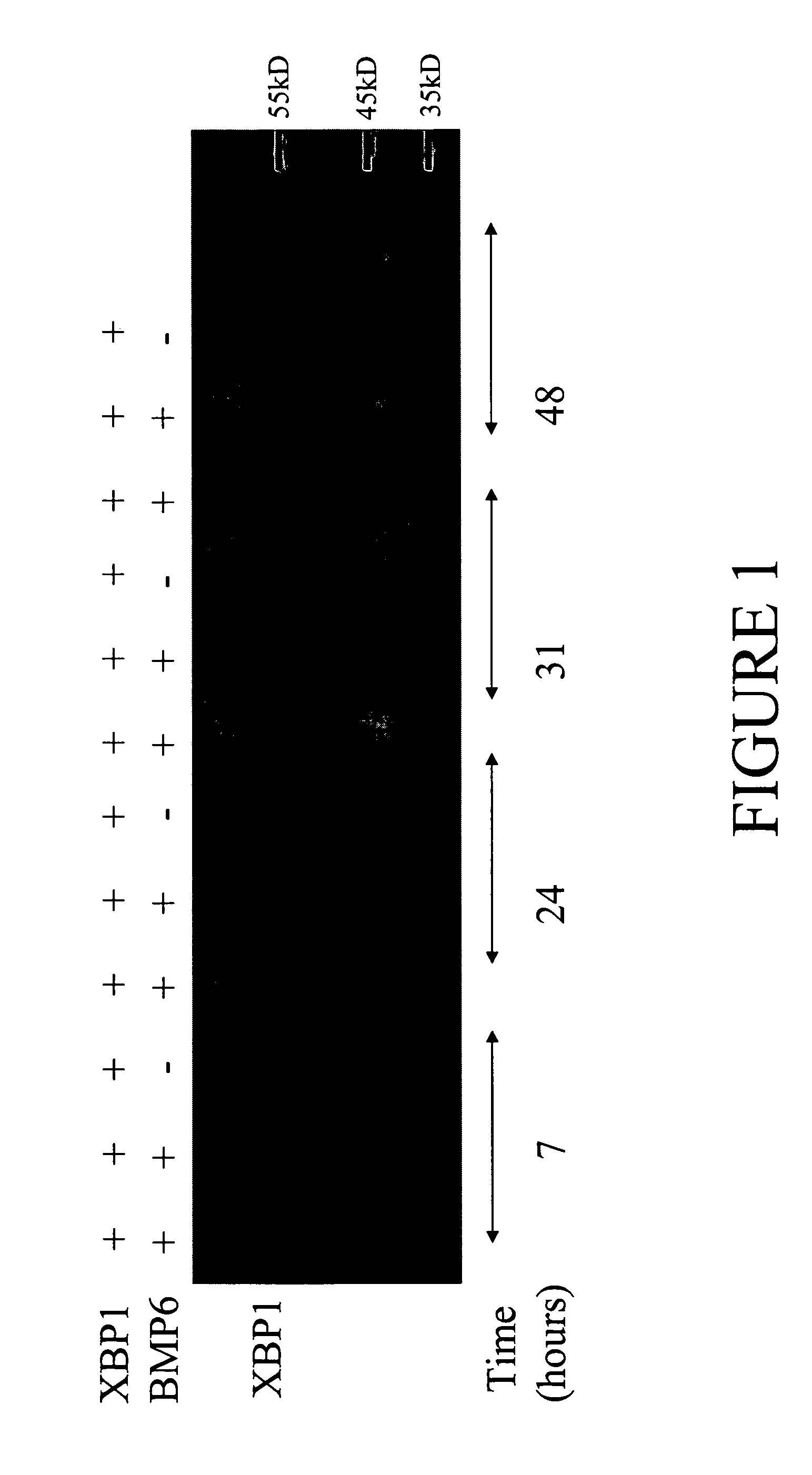Systems and methods for protein production
a protein and protein technology, applied in the field of expression systems, can solve the problems of low production yield, translation attenuation, cell stress, etc., and achieve the effect of improving production yield and enhancing protein folding or processing capacity
- Summary
- Abstract
- Description
- Claims
- Application Information
AI Technical Summary
Benefits of technology
Problems solved by technology
Method used
Image
Examples
example 1
COS-1 and DUKX Cell Lines
[0094] COS-1 cells were obtained from American Type Culture Collection (ATCC), Manassas, Va., with ATCC number CRL-1650. CHO DUKX cells and PA DUKX cells were both derived from CHO-K1 (ATCC number CCL-61), which is a derivative of the Chinese hamster ovary (CHO) cells.
[0095] The CHO DUXK cells, which are also referred to as DUXK B11 or DXB11 cells, are deficient in production of dihydrofolate reductase (dhfr), a critical enzyme in the process of DNA replication. To select cells in which both dhfr alleles were mutated, Urlaub and Chasin, PROC. NATL. ACAD. SCI. U.S.A., 77:4216-4220 (1980), performed the mutagenesis and selection in two steps. The selective agent used against dhfr+ cells was tritiated deoxyuridine. Tritiated deoxyuridine is toxic to cells due to its incorporation into DNA and subsequent radioactive decay. Incorporation of deoxyuridine into DNA requires its conversion to thymidilic acid, a process for which DHFR is essential. dhfr− mutant cell...
example 2
Induction of ER stress by Overexpression of BMP6 in PA DUKX Cells
[0102] pSMED2 / XBP1 and pSMED2 / BMP6 (+) or empty pSMED2 vector (−) were cotransfected into PA DUKX cells. pSMED2 / XBP1 and pSMED2 / BMP6 expression vectors encode XBP1 and BMP6, respectively. Both vectors are driven by a CMV promoter. Transfections were carried out in 6-well plates using Fugene6 (Roche, Indianapolis, Ind.). The growth medium for the cells was Alpha media (Gibco) supplemented with nucleosides and 10% FBS (heat inactivated and dialyzed) and Penicillin / Streptomycin / Glutamine (Gibco).
[0103] Cells were lysed in Cell Lysis Buffer (Cell Signaling Technology, Beverly, Mass.) with the addition of 400 mM NaCl and 1 Complete Mini (a protease inhibitor cocktail tablet from Roche, Indianapolis, Ind.). Lysates were taken at 7, 24, 31, and 48 h after transfection and run on a 10% tricine gel, followed by Western blot analysis (FIG. 1). The Western blot analysis was performed by using a blocking buffer of 4% non-fat dry...
example 3
Cell Lines Stably Transfected with XBP1
[0104] pSMED2 / XBP1 vector was transfected into CHO DUKX cells to create stable cell lines. DFHR gene on the pSMED2 vector allows for methotrexate (MTX) resistance. Transfected cells were plated in 5, 10, or 20 nM MTX concentrations. Three 5 nM MTX colonies (5-2, 5-4, 5-5), one 10 nM colony (10-3), and one 20 nM colony (20-10) were isolated. Cells from each colony were treated with (+) or without (−) tunacymicin (Tu), a chemical known to cause ER stress. Lysates were run on a 10% tricine gel, followed by Western blot analysis (FIG. 2) using rabbit polyclonal anti-XBP1 antibody (Santa Cruz Biotechnology). FIG. 2 demonstrates that more mature XBP1 was produced in XBP1 stable cell lines when the cells were stressed by Tu treatment.
[0105] pSMED2 / BMP6 was transiently transfected into XBP1 stable (5-2,5-4, and 20-10) and parental (CHO DUKX) cell lines. Conditioned media collected 48 h after transfection were run on a 10% tricine gel, followed by Wes...
PUM
| Property | Measurement | Unit |
|---|---|---|
| concentration | aaaaa | aaaaa |
| volume | aaaaa | aaaaa |
| volume | aaaaa | aaaaa |
Abstract
Description
Claims
Application Information
 Login to View More
Login to View More - R&D
- Intellectual Property
- Life Sciences
- Materials
- Tech Scout
- Unparalleled Data Quality
- Higher Quality Content
- 60% Fewer Hallucinations
Browse by: Latest US Patents, China's latest patents, Technical Efficacy Thesaurus, Application Domain, Technology Topic, Popular Technical Reports.
© 2025 PatSnap. All rights reserved.Legal|Privacy policy|Modern Slavery Act Transparency Statement|Sitemap|About US| Contact US: help@patsnap.com



